Antibiotics in animal and vegetable products
Antibiotics are usually systematically administered to livestock in a preventive way against infections and also in order to make them grow bigger so that their value increases. Supposedly about 80% of the antibiotic production worldwide is destined to this purpose.Farmed fish are systematically fed antibiotics, too.
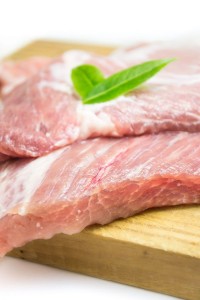 Subsequently, these antibiotics are found in animal products used for human consumption: meat, fish, milk, dairy products, eggs, etc. And the bacteria that live in these animals also develop antibiotic resistance, which is then transmitted to humans.
Subsequently, these antibiotics are found in animal products used for human consumption: meat, fish, milk, dairy products, eggs, etc. And the bacteria that live in these animals also develop antibiotic resistance, which is then transmitted to humans.Regarding the organic products, antibiotics are banned in most countries in livestock as a preventive measure, however, vets are usually allowed to prescribe them in case it is necessary. Phytotherapeutic antibiotics are allowed in any case. (1)
Pesticides sprayed on vegetables have an antibiotic effect as well.
Natural antibiotics
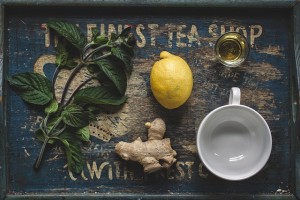 Among “grandmother’s home remedies” to fight against bacterial infections some of the most traditional ones are raw garlic, raw onion, honey, lemon juice and coconut oil. Concerning naturopathic remedies, there is a wide range of products: essential oils, herbal infusions, homeopathy, medicinal mushrooms, and a long etcetera.
Among “grandmother’s home remedies” to fight against bacterial infections some of the most traditional ones are raw garlic, raw onion, honey, lemon juice and coconut oil. Concerning naturopathic remedies, there is a wide range of products: essential oils, herbal infusions, homeopathy, medicinal mushrooms, and a long etcetera. Other products that have been traditionally used for the preservation of food also present antimicrobial properties: salt, sugar, spices and herbs.
Food additives with a preservative effect, although not natural, also have antibiotic properties. All labels between E-200 and E-299 are considered in this group. Moreover, some antioxidants, acidity regulators, flavor enhancers and other additives also may have an antimicrobial effect.
The effects of antibiotics on the gut flora
The word antibiotic means “against life”. As we know, antibiotics are used to fight bacterial infections and they cause unwanted side effects: gut flora damage which can lead to diarrhoea, loss of appetite, tummy ache; possible allergies and photosensitivity; liver and kidney overload, and a long list depending on the medicine.Gut flora plays a key role in keeping us healthy. In this post you can read why a balanced gut flora is so important.
 Natural medicine accuses antibiotics of indiscriminately destroying the gut flora, killing not only pathogenic bacteria but also beneficial bacteria.
Natural medicine accuses antibiotics of indiscriminately destroying the gut flora, killing not only pathogenic bacteria but also beneficial bacteria.Rebuilding the balance of gut flora takes a long time and a lot of effort. Some studies say that it is almost impossible to recover it completely. What is more, the desert that is left after the antibiotics is populated by several opportunistic resistant bacteria, such as Candida and other yeasts and fungi.
Probiotics, both as medicine and in the form of food, a proper diet, and other therapies may help this very difficult process of restoring gut flora, which gets worse with ageing, compromising health seriously in the long term.
Studies about the exact effect of antibiotics on gut flora are quite divergent.
Pharmaceutical companies publish studies which prove that a huge number of antimicrobial medicines do not touch the beneficial gut flora. “ 46 Lactobacillus strains from human and dairy sources were assayed for susceptibility to 44 antibiotics. All strains were resistant to a group of 14 antibiotics…. “ (2)
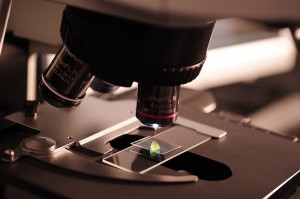
All the studies about the impact of antibiotics on different bacterial strains have been performed in vitro, that is, in a lab, so it is not clear if the same results can be extended in vivo, that is, on the human gut flora. When an antibiotic in ingested, it must cross different stages of the digestive system until it gets to the intestine, so it is doubtful that the antimicrobial effect could resist until the intestine. Specifically, the action of the hydrochloric acid in the stomach may be the responsible of the supposed lack of effectiveness. This is why antimicrobial medicines are covered by an enteric capsule, which is resistant to hydrochloric acid. However, natural antibiotics that are consumed as food may be neutralised in the stomach because of the lack of protection.
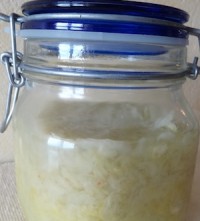 Some doctors have a different opinion. Dr. Campbell-McBride (3) states that the probiotic bacteria that is contained in sauerkraut may reach the intestine better and may be more effective in the gut flora restoration than probiotic capsules. “Supplements of probiotics settle in the upper parts of the digestive system and generally do not make it all the way down to the bowel, while fermented foods will carry probiotic bacteria all the way down to the end of the digestive system.”
Some doctors have a different opinion. Dr. Campbell-McBride (3) states that the probiotic bacteria that is contained in sauerkraut may reach the intestine better and may be more effective in the gut flora restoration than probiotic capsules. “Supplements of probiotics settle in the upper parts of the digestive system and generally do not make it all the way down to the bowel, while fermented foods will carry probiotic bacteria all the way down to the end of the digestive system.”Summer Bocks (4) adds that sauerkraut “is one of the only foods that contains natural bacteria that inoculate and live within your intestines.” She argues that the cabbage where the probiotics are carried protects them and gives them a “home” and nourishment to get to the intestine and settle there.
In the same way as probiotic bacteria contained in food may reach the intestine more easily, antibiotic substances may reach the gut more easily as well.
Apart from all these scientific studies about the topic, I personally share the opinion stated by the Science of Life: “Any agent which is so poisonous as to cause immediate death to any other living organism should never be consumed” (5) and by John Brisson “Any anti-microbial natural or otherwise is nondiscriminatory. Therefore it will kill off the good and the bad” (6)
I will expose an example below: the effect of salt, spices and herbs on the gut flora.
Salt, spices and herbs
 Salt and spices have been used since ancient times for food preservation: salt cod and salt-cured ham in Spain; sauerkraut and pickled vegetables in Northern Europe; soy products such as soy sauce and miso in Asia; curry and masala in India, etc.
Salt and spices have been used since ancient times for food preservation: salt cod and salt-cured ham in Spain; sauerkraut and pickled vegetables in Northern Europe; soy products such as soy sauce and miso in Asia; curry and masala in India, etc.The fact that salt has been used to preserve food is because bacteria and fungi development is stopped when the concentration of salt is very high. The inhibition of bacterial growth begins to be present when the concentration of salt is very low, and there is a proportionally growing effect when the concentration is increased. (7), (8).
The effect of salt on every bacterial species is different. Some of them are more resistant than others, but there isn’t a big difference among the species of bacteria that usually inhabit the intestine. However, undesirable fungi and yeasts that may be found in the gut show a higher resistance to salt. (7) And only some sea bacteria resist a very high concentration of salt (8).
In the sauerkraut, for example, the concentration of salt is enough for lactobacilli to develop to a certain point. The lactic acid produced by these beneficial bacteria avoids the development of other undesirable bacteria. The content of lactobacilli in the sauerkraut is responsible for the beneficial probiotic properties of this food.
Even if the amount of salt in our food is not high enough to kill the gut bacteria, its inhibiting action shouldn’t be disregarded. What is more, it has to be considered that harmful yeasts and fungi in the intestine hold a higher resistance.
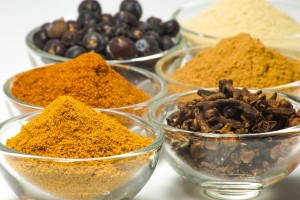 Spices and herbs show different antimicrobial properties depending on the type. Cinnamon, clove and mustard have strong antimicrobial properties; cumin, coriander, oregano, sage, rosemary and thyme have a medium effect, while pepper and ginger have a weak effect. Every spice has a specific nature for different type of bacteria. In studies about the subject the action of these substances against pathological bacteria (salmonella, e-coli, aspergillums, staphylococcus, etc.) is described, but there is no information about the effect against beneficial bacteria. (9)
Spices and herbs show different antimicrobial properties depending on the type. Cinnamon, clove and mustard have strong antimicrobial properties; cumin, coriander, oregano, sage, rosemary and thyme have a medium effect, while pepper and ginger have a weak effect. Every spice has a specific nature for different type of bacteria. In studies about the subject the action of these substances against pathological bacteria (salmonella, e-coli, aspergillums, staphylococcus, etc.) is described, but there is no information about the effect against beneficial bacteria. (9)Other issues to be considered
Every antimicrobial medicine, even if it’s natural, has side effects at other levels.The risks of salt on health are well known: hypertension, renal disorders, fluid retention, etc.
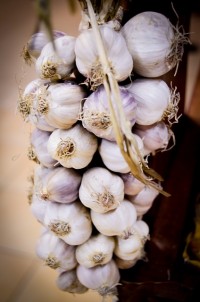 Garlic and onion are extremely irritating for the stomach, interfere with the metabolism of fats in the liver, disturb the thyroid function (they are goitrogens), lead to anemia, they are anticoagulant, etc.
Garlic and onion are extremely irritating for the stomach, interfere with the metabolism of fats in the liver, disturb the thyroid function (they are goitrogens), lead to anemia, they are anticoagulant, etc.Sugar, once in the intestine, has a completely opposite effect, this is, it feeds every type of fermentation bacteria (lactibacillus, bifidus, enterococcus and streptococcus), and particularly fungi and yeasts. Also, it inhibits the inmune system, it’s demineralizing, and it entails the risk of diabetes. You can learn more about the problems associated with sugar here.
Spices and herbs also have side effects, which depend on the substance. Spices are very allergenic. Pepper, for example, may trigger asthma, it is irritating for the stomach and may cause reflux, heartburn and even ulcers and hemorrhaging. Thyme, for example, decreases the coagulation of blood and has estrogenic effects.
Negative emotions, stress, toxins, hygiene and cleaning products, electromagnetic pollution, etc
Mercury is known for being the most powerful antimicrobial agent. There is mercury in dental amalgams, vaccines, big fish such as tuna, coal industries, mercury thermometers, low energy light bulbs, etc.Negative emotions and stress have an inhibiting bacterial effect too, as it is explained in this study published in the journal Brain, Behavior and Immunity: “Studies from this laboratory have shown that stressor exposure impacts the stability of the microbiota and leads to bacterial translocation. The biological importance of these alterations, however, is not well understood”. (10)
Cleaning and hygiene products, in addition to the harmful chemical products that they contain, also disturb the bacterial flora that inhabits our skin and the respiratory and vaginal mucosa, which are essential for our health.
 Companies that manufacture these products invest a lot of money in advertising them in order to convince us and make us become obsessed, mainly the mothers, about the need of keeping a clean home to the extreme of sterility. However, it has been shown that the contact with dirt to certain degree, that is bacteria, is beneficial for our immune system, mainly children’s, as a way of immunization. Children that live in the country or that have pets develop fewer allergies than the ones that live in cities. (11)
Companies that manufacture these products invest a lot of money in advertising them in order to convince us and make us become obsessed, mainly the mothers, about the need of keeping a clean home to the extreme of sterility. However, it has been shown that the contact with dirt to certain degree, that is bacteria, is beneficial for our immune system, mainly children’s, as a way of immunization. Children that live in the country or that have pets develop fewer allergies than the ones that live in cities. (11)Read this article to get to know more about toxins to which we are most usually exposed to.
An alternative theory
Science of Life states an alternative theory about the role of bacteria in the body. According to their approach, based on the studies of Claude Bernard, a contemporary of Pasteur, all bacteria play an important role in the body, so they shouldn’t be eradicated. Bacteria are in charge of cleaning the organism of toxins, harmful food and other undesirable products that have penetrated into the organism by the respiratory tract, digestive system or the skin.When there is no source of pollution in our body, bacteria naturally disappear, because there is nothing to feed them with. However, some kinds of bacteria produce toxins as a result of their metabolism, which must be removed from de body.
T.C. Fry states in his lessons of The Life Science Health “When the body has a highly toxic condition such as inflammation, it will absorb bacteria from the intestinal cavity and transport them to the point where deadly materials have been concentrated. The bacteria then symbiotically assist in breaking up these toxic materials for elimination. Of course, the excreta of bacteria are toxic, too.
Bacteria never exist in a proliferating state where there is no food or soil for their propagation. They multiply when there is feast, and they die off when there is famine or adverse environment, hence, bacteria no more create their food supply than flies cause garbage. The garbage must preexist the flies and, on the same order, the garbage or soil on which bacteria thrive in our bodies must preexist their presence and propagation.
At their strongest, bacteria complicate disease because the byproducts of bacterial fermentation or putrefaction are deadly poison. They are toxic within organisms, although the body can normally eliminate these poisons” (12)
So in order to have a healthy gut flora and eliminate undesirable bacteria, a proper nutrition and healthy lifestyle is the key, avoiding every food that does not profit our body and could feed bacteria. This point of view is shared by Dr. Campbell-McBride as well.
Simply by having a balanced diet and an appropriate lifestyle we can do well enough to eliminate all the undesirable bacteria.
When an antibiotic is administered, undesirable bacteria are temporally destroyed, but if an unhealthy diet and lifestyle persists, bacteria will appear again short time afterwards.
Following this reasoning, it is easy to understand why antibiotic resistance is developed. As long as there is food that feeds them, they will continue thriving in the body.
Learn more about this approach on this page.
Conclusions
Every product with antibiotic properties, both natural and chemical, exercises a strain on the gut flora, so that some strains which are more resistant to these products are favoured.Scientific research doesn’t give enough detailed information about which is the impact of different products with antibiotic properties, so my advice is to avoid them as much as possible, in order to avoid the development of antibiotic resistance when they may be really necessary. None of these products is necessary in our diets anyway, besides they cause other adverse effects.
In order to avoid the need for antibiotics, prevention is preferable, following a healthy lifestyle, with a proper nutrition. Bacteria, as all living entities, do not survive if they are not fed.
Bibliography:
(1) “Principios de producción orgánica”, FAO
(2) “Antibiotic susceptibility of potentially probiotic Lactobacillus species”, J Food Prot
(3) “Gut and Psychology Syndrome”, Dr. Natasha Campbell-McBride
(4) “The Power of Probiotics for Digestive & Immune Healing”, Summer Bocks
(5) “The Garlic Plant”, T.C.Fry
(6) “Fix your Gut”, John Brisson
(7) “Effect of salt content on microbiological properties in processed meat products”
(8) “The Effects of Salt Concentration on Bacterial Growth”, Ryan Marc
(9) “Antimicrobial effects of spices and herbs”, Hospitality Institute of Technology and Management St. Paul, Minnesota
(10) “Exposure to a social stressor alters the structure of the intestinal microbiota: Implications for stressor-induced immunomodulation “, Brain, Behavior and Immunity
(11) “City children far more likely to have food allergies than those living in the country”, The Telegraph
(12) “Toxemia is the universal cause of disease”
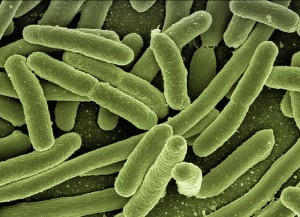 Nowadays, concern about antibiotic resistance seems to be growing: antibiotics are losing their effectiveness due to new kinds of super-resistant bacteria. This phenomenon exists because doctors prescribe antibiotics too often.
Nowadays, concern about antibiotic resistance seems to be growing: antibiotics are losing their effectiveness due to new kinds of super-resistant bacteria. This phenomenon exists because doctors prescribe antibiotics too often.











